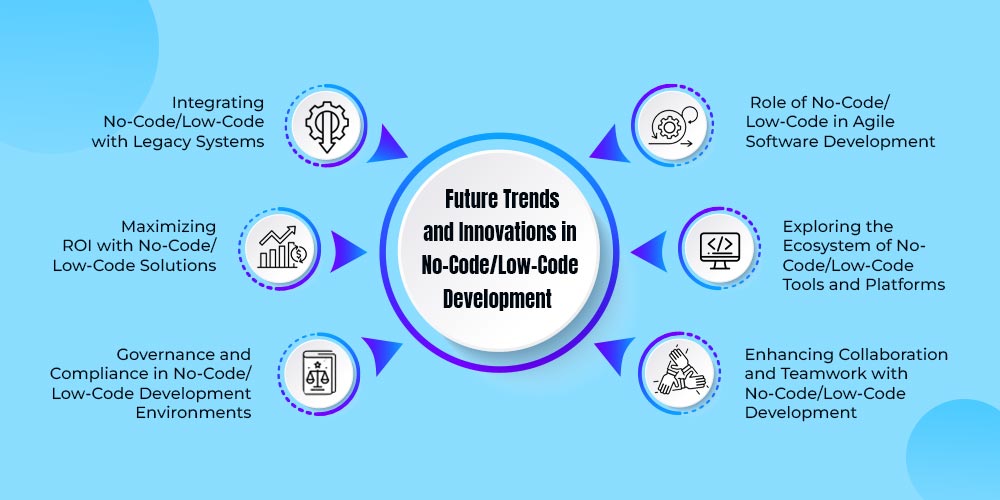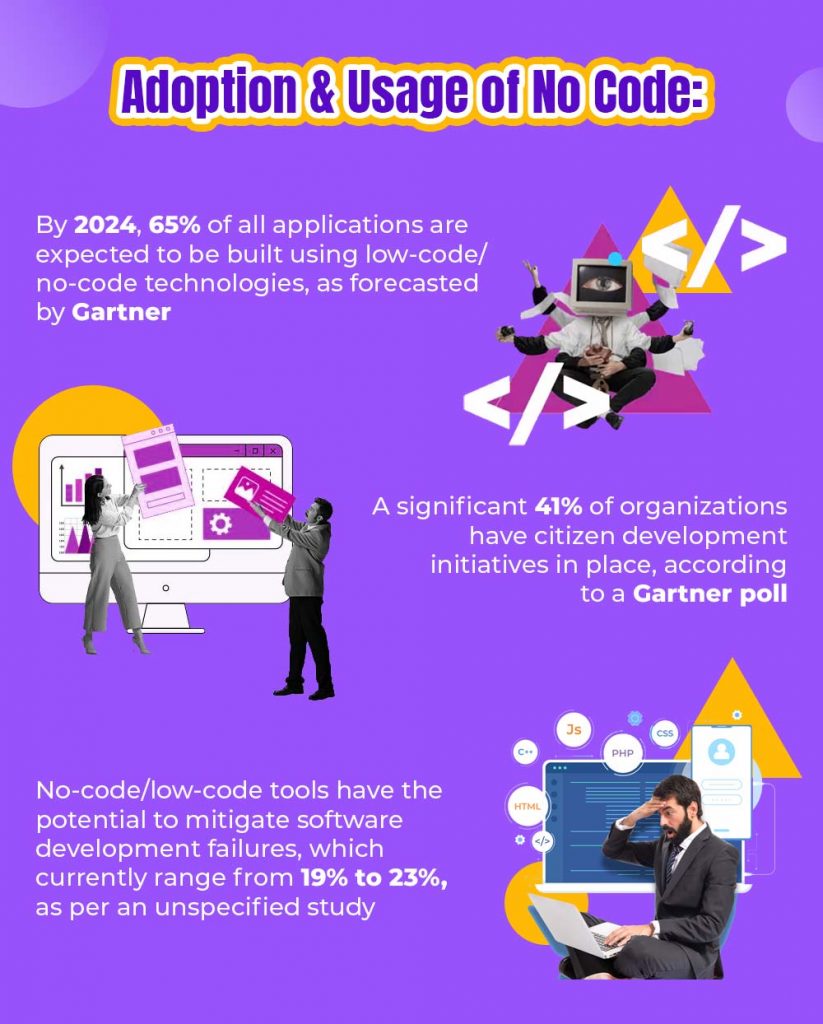Unlocking Digital Transformation: A Deep Dive into Low Code and No Code Development
In recent years, the landscape of software development has been revolutionized by the emergence of no-code and low-code platforms. These platforms, designed to empower both technical and non-technical users, have rapidly gained popularity due to their ability to accelerate digital transformation and streamline application development processes. In this comprehensive blog, we will delve into the evolution, benefits, challenges, and future trends of no-code and low-code development, backed by insightful statistics and real-world examples.


Evolution and Growth of No-Code/Low-Code Platforms
No-code and low-code development platforms have undergone significant evolution since their inception. Originally conceived as tools to enable citizen developers to create simple applications without coding, these platforms have evolved into sophisticated solutions capable of supporting complex enterprise-grade applications. According to industry forecasts, the global low-code platform market revenue is projected to reach $32 billion by 2024, with a compound annual growth rate (CAGR) of 26.1%.
Advantages and Benefits of No-Code/Low-Code Development
One of the key advantages of no-code and low-code development is their ability to democratize software development, allowing users with varying levels of technical expertise to participate in the creation of digital solutions. These platforms significantly reduce development time and cost, with Gartner forecasting that 70% of new applications will be built with low-code/no-code platforms by 2025. Additionally, businesses report an average reduction of 90% in app development time using no-code and low-code development services.
Use Cases and Applications of No-Code/Low-Code in Various Industries
No-code and low-code platforms are being used across diverse industries to address a wide range of business challenges. From streamlining internal workflows and automating repetitive tasks to enhancing customer experiences and accelerating time-to-market for new products, the applications of these platforms are virtually limitless. For instance, 41% of organizations have active citizen development initiatives, with 20% evaluating or preparing to start such initiatives.
Comparison: No-Code vs. Low-Code Development Approaches
While both no-code and low-code development approaches share the goal of simplifying application development, there are key differences between the two. No-code platforms typically require minimal to no coding knowledge and are designed for citizen developers, while low-code platforms offer greater flexibility and customization options, catering to professional developers and power users. However, both approaches offer significant advantages in terms of speed, agility, and accessibility.
Exploring the Key Features of Leading No-Code/Low-Code Platforms
Leading no-code and low-code platforms offer a wide range of features and capabilities to support various aspects of the development lifecycle. These include drag-and-drop visual interfaces, pre-built templates and components, integration with third-party services, collaboration tools, and robust security features. By leveraging these features, organizations can rapidly prototype, deploy, and iterate on applications with ease.
How No-Code/Low-Code Accelerate Digital Transformation
No-code and low-code platforms play a crucial role in accelerating digital transformation initiatives within organizations. By enabling rapid application development and deployment, these platforms empower businesses to respond quickly to changing market demands, streamline internal processes, and enhance customer engagement. According to Forrester, the use of low-code application platforms is expected to accelerate legacy modernization efforts, with nearly 35% of government legacy applications projected to be replaced by solutions built on low-code platforms by 2025.
Empowering Citizen Developers with No-Code Platforms
Citizen developers, individuals with limited or no coding experience, are increasingly empowered to participate in the development of digital solutions using no-code platforms. These platforms provide intuitive, user-friendly interfaces that allow citizen developers to create applications by simply dragging and dropping components onto a canvas. As a result, businesses can tap into the creativity and domain expertise of employees across departments, fostering innovation and collaboration.
Best Practices for Successful Implementation of No-Code/Low-Code Solutions
Successful implementation of no-code and low-code solutions requires careful planning, collaboration, and adherence to best practices. Organizations should start by identifying use cases that are well-suited for no-code or low-code development and establish clear governance and compliance policies. Additionally, providing training and support to users, fostering a culture of experimentation, and continuously monitoring and optimizing processes are essential for maximizing the benefits of these platforms.
Addressing Security Concerns in No-Code/Low-Code Development
Security is a paramount concern in no-code and low-code development, given the potential risks associated with user-generated code and integrations with external systems. To mitigate these risks, organizations should implement robust security measures, such as role-based access controls, encryption, and regular security audits. Additionally, partnering with reputable vendors that prioritize security and compliance is crucial for safeguarding sensitive data and ensuring regulatory compliance.
Overcoming Challenges in No-Code/Low-Code Development Projects
While no-code and low-code development offer numerous benefits, they also present certain challenges that organizations must address. Common challenges include limited customization options, scalability concerns, potential vendor lock-in, and security risks. By adopting a holistic approach to project management, fostering collaboration between IT and business teams, and leveraging best practices and industry standards, organizations can overcome these challenges and drive successful outcomes.
Case Studies: Real-world Examples of Successful No-Code/Low-Code Projects
Real-world case studies provide valuable insights into the practical applications and benefits of no-code and low-code development. For example, a multinational corporation utilized a low-code platform to streamline its procurement process, resulting in a 40% reduction in cycle time and significant cost savings. Similarly, a healthcare provider leveraged a no-code platform to develop a patient engagement app, leading to improved patient satisfaction and outcomes.


Future Trends and Innovations in No-Code/Low-Code Development
Looking ahead, the future of no-code and low-code development is characterized by continued innovation and expansion. Emerging trends such as AI-driven automation, containerization, and edge computing are poised to reshape the landscape of application development. Additionally, the convergence of no-code and low-code platforms with other technologies, such as blockchain and IoT, holds promise for unlocking new use cases and driving further adoption across industries.
Integrating No-Code/Low-Code with Legacy Systems
Integrating no-code and low-code solutions with legacy systems presents both challenges and opportunities for organizations. While legacy systems often pose compatibility issues and may lack modern APIs, no-code and low-code platforms offer tools and connectors that facilitate seamless integration. By adopting an incremental approach to modernization, organizations can gradually replace legacy systems with more agile and scalable solutions while minimizing disruption to existing operations.
Maximizing ROI with No-Code/Low-Code Solutions
Maximizing return on investment (ROI) with no-code and low-code solutions requires careful planning, execution, and measurement of key performance indicators (KPIs). Organizations should assess the total cost of ownership (TCO) of implementing and maintaining these platforms, including upfront costs, ongoing licensing fees, and resource requirements. Additionally, tracking metrics such as time-to-market, cost savings, productivity gains, and user satisfaction can provide valuable insights into the impact of no-code and low-code initiatives on business outcomes.
Governance and Compliance in No-Code/Low-Code Development Environments
Governance and compliance are critical considerations in no-code and low-code development environments, particularly in regulated industries such as finance, healthcare, and government. Organizations must establish clear policies and procedures for data privacy, security, and regulatory compliance to ensure that no-code and low-code applications meet industry standards and legal requirements. This includes implementing access controls, data encryption, audit trails, and regular compliance audits to mitigate risks and maintain trust with stakeholders.
Role of No-Code/Low-Code in Agile Software Development
No-code and low-code development methodologies align closely with agile principles, enabling organizations to deliver software iteratively and respond quickly to changing requirements. By breaking down complex projects into smaller, manageable tasks and fostering collaboration between cross-functional teams, no-code and low-code platforms support agile development practices such as continuous integration, continuous delivery, and iterative testing. This iterative approach promotes flexibility, adaptability, and customer-centricity, driving better outcomes for organizations.
Exploring the Ecosystem of No-Code/Low-Code Tools and Platforms
The ecosystem of no-code and low-code tools and platforms is diverse and rapidly evolving, with a wide range of offerings tailored to different use cases and industries. From simple drag-and-drop builders to sophisticated AI-powered automation platforms, organizations have access to a wealth of tools and resources for accelerating application development and digital transformation initiatives. Understanding the strengths, limitations, and integrations of various no-code and low-code platforms is essential for selecting the right solution to meet specific business needs and objectives.
Enhancing Collaboration and Teamwork with low code and no code development
No-code and low-code development foster collaboration and teamwork by empowering cross-functional teams to work together on application development projects. With intuitive visual interfaces and built-in collaboration features, these platforms enable developers, business analysts, and subject matter experts to collaborate in real-time, share feedback, and iterate on designs efficiently. This collaborative approach promotes transparency, communication, and alignment across teams, leading to better outcomes and higher levels of innovation.
Best Practices for Designing User-friendly Interfaces in No-Code/Low-Code Apps
Designing user-friendly interfaces is essential for ensuring the success and adoption of no-code and low-code applications. Organizations should prioritize usability, accessibility, and aesthetics when designing interfaces, taking into account the needs and preferences of end-users. Utilizing design principles such as consistency, simplicity, and feedback, and conducting user testing and feedback sessions can help identify and address usability issues early in the development process. Additionally, providing comprehensive documentation and training resources can empower users to navigate and interact with applications effectively.
Insights into the Impact of No-Code Development Platforms
In the realm of software development, no-code and low-code solutions have emerged as powerful catalysts, reshaping how applications are created and deployed. As organizations strive to navigate the intricacies of modern technology, these platforms offer a compelling solution, democratizing the creation process, and accelerating digital innovation.
Key Statistics: A Glimpse into the Landscape
Market Growth:
- The global low-code and no-code market size is projected to reach $26.9 billion by 2026, as reported by Gartner.
- An astonishing 82% of organizations face challenges in attracting and retaining qualified software engineers, according to an unspecified study.


Adoption & Usage of No Code:
- By 2024, 65% of all applications are expected to be built using low-code/no-code technologies, as forecasted by Gartner.
- A significant 41% of organizations have citizen development initiatives in place, according to a Gartner poll.
- No-code/low-code tools have the potential to mitigate software development failures, which currently range from 19% to 23%, as per an unspecified study.
- An impressive 89% of non-users express willingness to adopt no-code tools in the future.
- Over 1024% of users had no prior experience with no-code/low-code before utilizing them, with 40% having primarily business backgrounds.
- Despite their widespread use, 37% of enterprises utilizing low-code/no-code platforms have not built and delivered any of their highest-value applications with them.
- Remarkably, 1372% of users develop apps with low-code applications in three months or less.
Benefits:
- No-code/low-code tools enable developers to create cloud-native applications 10 times faster, with 70% fewer resources, as indicated by Forrester.
- McKinsey reports that businesses can increase developer velocity and be 65% more innovative with the right tools.
- Companies that integrate these technologies throughout development witness a 47% increase in innovation.
Challenges with No Code Technologies:
- While no-code/low-code platforms offer numerous benefits, they also pose certain challenges. Security risks require careful planning and governance to mitigate effectively.
- Scalability limitations may arise, particularly for complex applications.
- Integration issues with existing systems can occur, necessitating careful consideration during implementation.
- Vendor lock-in is a potential concern, highlighting the importance of evaluating platform flexibility and compatibility.
- Data governance requires attention, especially in environments where citizen development is prevalent.
As organizations navigate the evolving landscape of software development, leveraging no-code and low-code platforms can provide a competitive edge, driving innovation, efficiency, and agility. By understanding the benefits, addressing challenges, and staying informed about emerging trends, businesses can harness the full potential of these transformative technologies and pave the way for a digital future.
Conclusion
In conclusion, no-code and low-code development have emerged as powerful tools for accelerating digital transformation, empowering citizen developers, and driving innovation across industries. With their intuitive interfaces, visual design elements, and pre-built templates, these platforms democratize application development, enabling organizations to create custom solutions quickly and efficiently.
By embracing no-code and low-code methodologies, organizations can streamline their development processes, reduce time-to-market, and unlock new opportunities for growth and competitive advantage. However, it is essential to address security concerns, compliance requirements, and integration challenges to ensure the successful adoption and implementation of these platforms.
As the landscape of technology continues to evolve, no-code and low-code development will play an increasingly critical role in shaping the future of software development. By staying informed about the latest trends, best practices, and innovations in the no-code and low-code ecosystem, organizations can position themselves for success in the digital age. Embracing the simplicity and flexibility of no-code and low-code development, businesses can unlock their full potential and drive meaningful change in the years to come.







